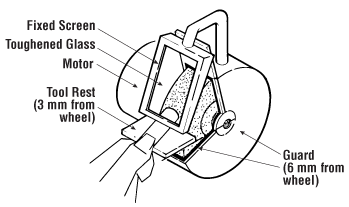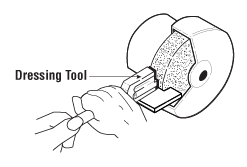Abrasive Wheels - Use of Bench and Pedestal Grinders
On this page
What safety procedures should you follow when using bench and pedestal grinders?
Back to top- An operator must be fully trained and instructed in the safe use, care, and protection from abrasive wheels before use.
- Fasten the pedestal and bench grinders on a solid surface securely.
- Ensure all the guards are in place and secure before using a grinder.
- Adjust tool rests to within 3 mm (1/8 in.) of wheels. Never adjust rests while the wheels are moving. Work rest height should be on a horizontal centre line of the machine spindle.
- Maintain 6 mm (1/4 in.) wheel exposure with a tongue guard or a movable guard.
- Check that the wheels have blotters on each side.
- Check the wheel fits properly to the spindle when mounting. If it is loose, get another wheel.
- Tighten the nuts before you turn the grinder on.
- Before you plug in the grinder, manually spin the wheel to make sure it is spinning freely.

- Make sure the cables are not damaged and in good condition.
- Keep the cables out of the work area.
- Wear proper personal protective equipment:
- eye, ear and face protection,
- metatarsal safety boots, where required, and
- respiratory protection may be required, depending on the work.
- Wear gloves only where necessary and if there is no risk of entanglement.
- Make sure all guards are in place.
- Inspect the wheel for chips or cracks before using.
- Stand to one side of the grinder until the wheel reaches operating speed.
- Bring work into contact with the grinding wheel slowly and smoothly without bumping.
- Apply gradual pressure to allow the wheel to warm up evenly. Use only the pressure required to complete a job.
- Move the work back and forth across the face of the wheel. This movement prevents grooves from forming.
- Wait for the piece to cool before touching the end.
- Wheels are made only for grinding certain items. Do not grind rough forgings on a small precision grinding wheel.

- Dress wheels regularly. Do frequent, light dressings rather than one heavy dressing.
- Support dressing tools so you can apply leverage without undue effort. With revolving cutter dressing tools, use the lugs as anchors.
- Replace worn wheels if you cannot dress it.
- Ensure the grinder speed does not exceed the operating speed marked on the wheel.
- Visually inspect wheels for possible damage before mounting.
- Clean the grinder and area after completing the work.
What should you avoid when using bench and pedestal grinders?
Back to top- Do not wear loose clothing or have long, loose hair (it may get caught in the spinning wheel).
- Do not plug the grinder in before making sure it and the wheel are stable and secured properly.
- Do not use a wheel that has been dropped.
- Do not use a wheel that does not fit properly to the spindle.
- Do not use excessive force to tighten the nut of the wheel. The force can crack the wheel.
- Do not adjust a grinder while it is moving.
- Do not grind wood, plastics and non-iron metals on ordinary wheels.
- Do not leave grinding wheels standing in liquids. The liquid can cause balance problems.
- Do not grind on the side of a regular wheel.
- Do not hold small pieces by hand.
- Fact sheet last revised: 2023-10-31

